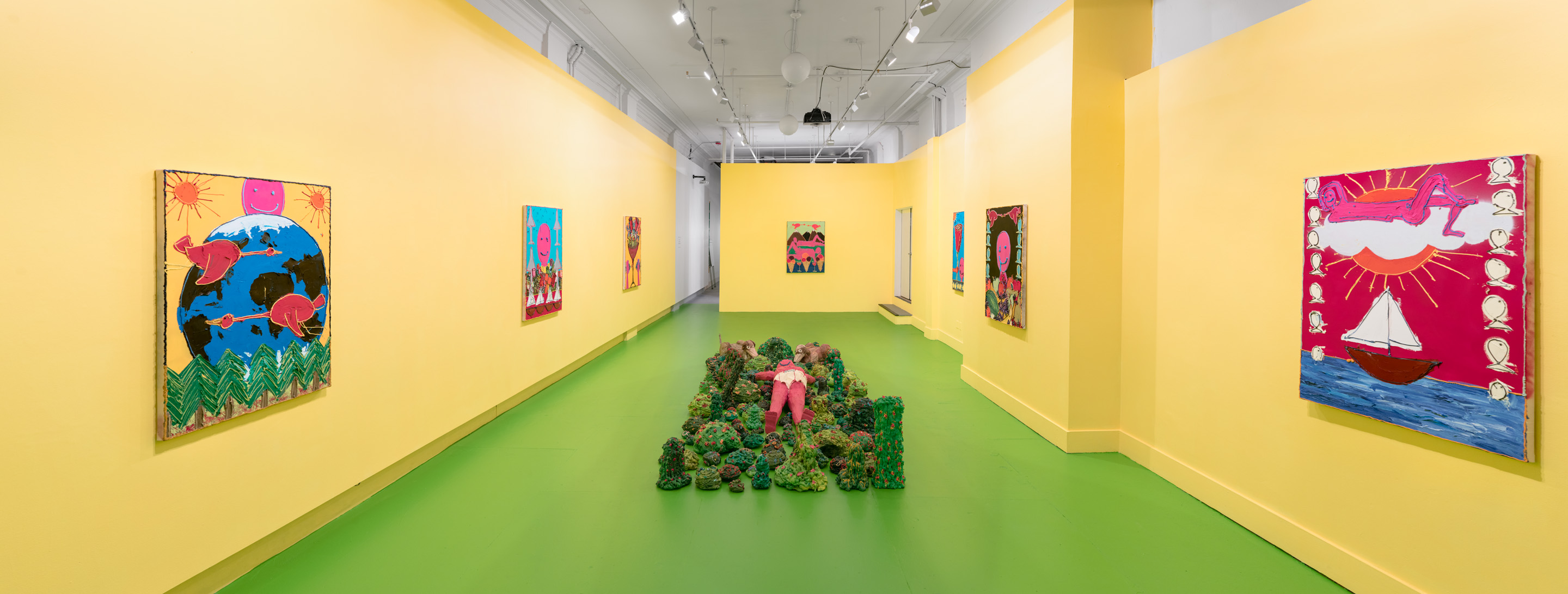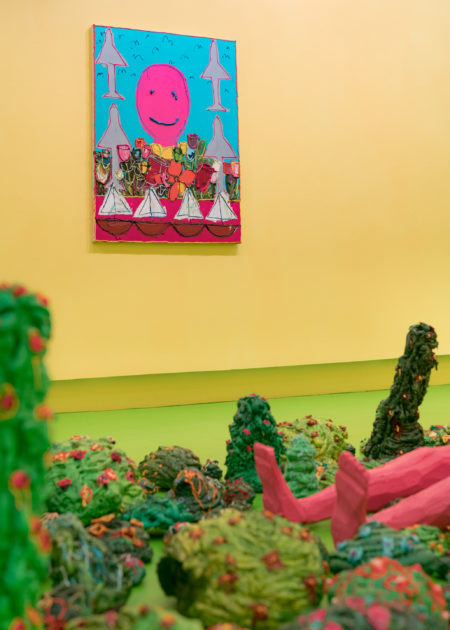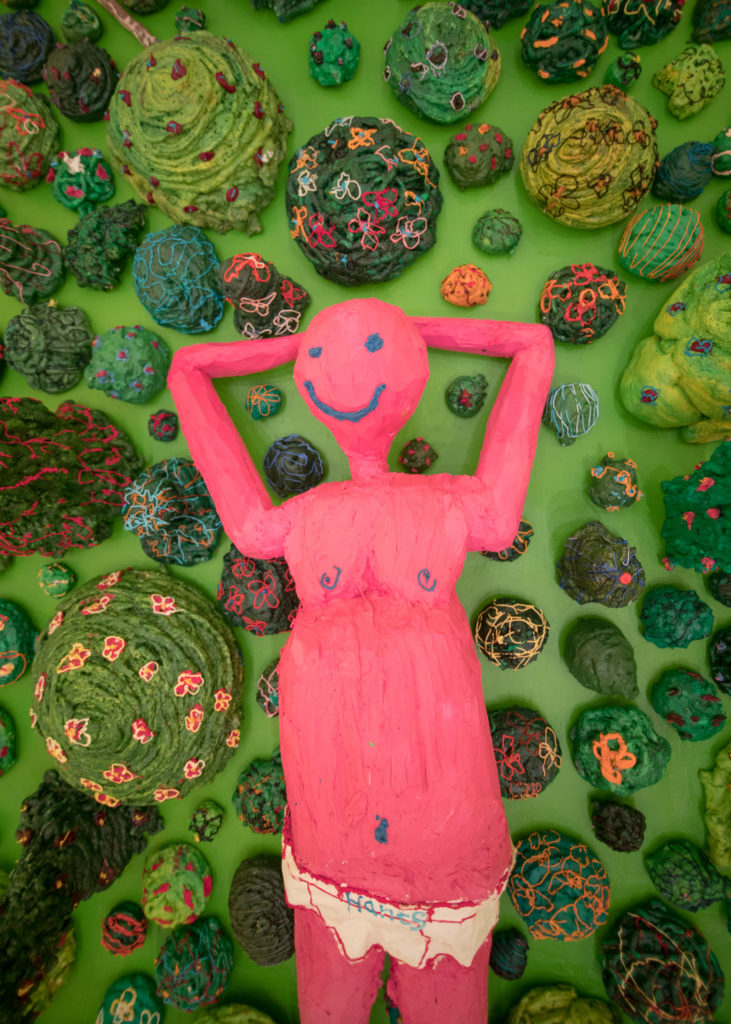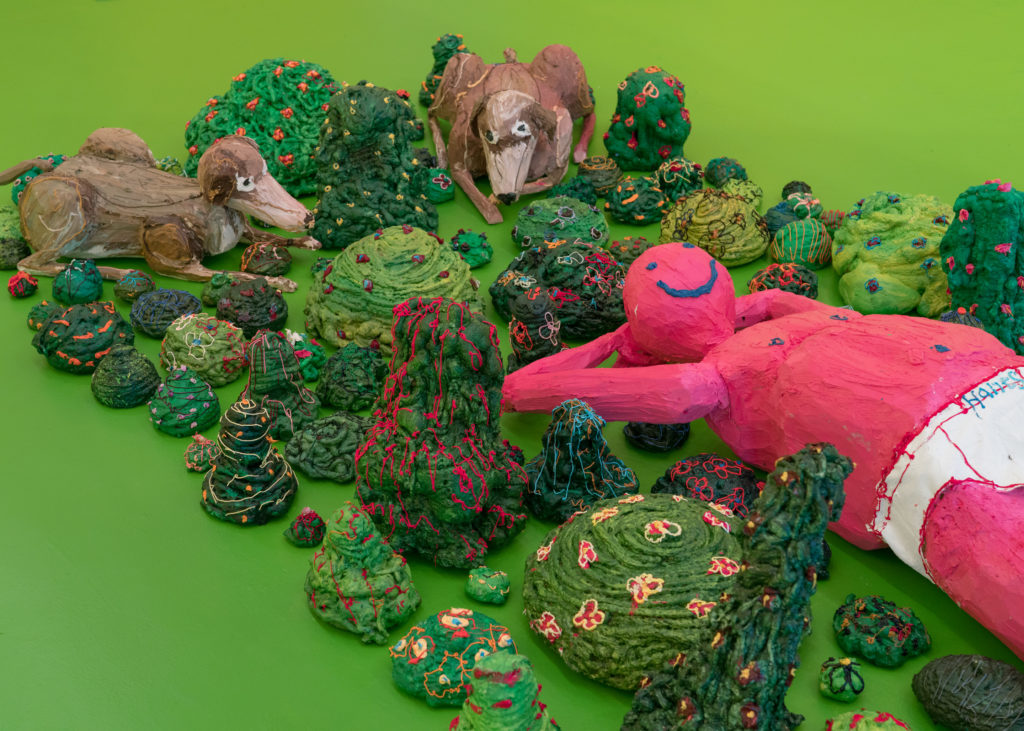by Julien Langevin
In the annex of SPACE Gallery, roses are everywhere: paintings of roses, roses squeezed out on top of phthalo green piles of paint, figures smelling roses. The sheer volume of flowers immediately raises questions of consumption and labor. In Dave Eassa’s Stop and Smell the Roses Sometimes, on view at SPACE Gallery, visitors come to realize that the objects are not singularly created for visual or tactile pleasure, but also show how the act of walking through nature is a cathartic privilege, to be savored and utilized.
Viewers are invited to poke around Eassa’s installation: with feet softly touching the bright green floor, they can interact intimately with this facsimile of nature. The central focus of Stop and Smell the Roses Sometimes is a fluorescent pink body lounging in a field of mound-like greenery, in part referencing a post-analog IRL plein air painting scene. The body wears nothing but a spackled pair of tight white underwear sporting the classic Hanes logo on the front. Dogs that appear to be constructed out of paint, spackle, and rudimentary armatures are positioned in a “barking” position, but the figure in the center seems to be unphased. This goofy narrative, surrounded by the yellow walls of the gallery and happy paintings, is definitely weird but it feels good.

The paintings on the walls that surround the central installation are products and windows at the same time. They represent production and labor associated with art object-making, but also offer optimism in these times when it can be difficult to find positivity. The yellow walls behind the paintings integrate the modestly-sized panels into the rest of the scene. Impasto images of human figures, wine glasses, airplanes, and flowers gather to signify relaxation and happiness, yet a hint of cynicism alludes to the capitalist marketing systems that tend to bombard consumers with these same suggestions. Eassa is clearly aware of the impact of these images as well as the symbolism as paintings themselves. Hidden in the rose bushes are sentiments of rejoice for a world outside, as well as reminders that, due to incarceration, a significant portion of our national population is forcibly unable to stop and smell the roses.

Eassa’s messages of optimism and joy are intertwined with his social activism. Working with groups like Maine Inside Out, a group that brings creative workshops into correctional facilities and shares original work with the community as a force for social change, Eassa’s work feels especially weighted.1 The United States, a nation that represents less than five percent of the world’s population, incarcerates an astounding twenty-five percent of the world’s prisoners, a statistic that is even more grossly unproportional when considering factors like race and class.2 Eassa’s multidisciplinary practice utilizes both art objects and activism to raise awareness about the United States’ abuse of incarcerated people and as a means to keep young people out of prison.
Eassa began his activism through an art program called Free Space at the Maryland Correctional Institute–Jessup in Jessup, Maryland. The program works to bring creative practices and classes to inmates in hope of improving their quality of life while incarcerated.3 Eassa, obsessed with making art objects, found that making art and skateboarding could be ways to evade prison or drugs — situations that many of his friends became victim to as children and young adults. He realized art might make a difference in other people’s lives the way it had in his, and that production could be positive both with and without a monetary gain.

The sheer amount of work in Stop and Smell the Roses Sometimes is telling when discussing notions of productivity and protest. Art making can be a vein in which to protest the abusive demands and products of capitalist systems of oppression, which can range from direct activism and social awareness to producing objects that create a critical dialogue. Both methods have decidedly different results but can work together to infiltrate toxic systems. Stopping to admire a flower can be a leisurely act and a radical act, one that eschews the monetary value of time for the value of experience. In societies that prioritize production and the utilize time as punishment through incarceration, acts of pure enjoyment are uncommon. Time is money; to bask in leisure under capitalism is to protest production. So what happens when joy strikes at an unpredictable, incalculable moment?
David Eassa’s Stop and Smell the Roses Sometimes at SPACE Gallery is a reminder of the value of optimism and how art can elicit joy’s soft, pleasurable pang to an unexpecting viewer. Surrounding viewers with gushing, goopy flowers and smiles, the show feels like sunshine. The show’s fabricated nature allows for its immediate read as a sanctuary of bliss and simultaneously alludes to darker tones of critique within capitalism. Mounds of squeeze-painted material become grass, a pink body in nothing but underwear becomes human, and roses painted with material straight from the tube become fragrant in Eassa’s installation. In the moment where a viewer experiences the joy of stopping to consider a loosely-painted rose, a new appreciation of the value of sensorial stimulation is born.

Dave Eassa’s Stop and Smell the Roses Sometimes runs through March 10th at SPACE Gallery Annex in Portland, ME, along with Past Tense with Jerrell Gibbs, Nicole Dyer, and Rachel Hayden.
On March 10th, SPACE Gallery will host an artist talk with Dave Eassa and Jerrell Gibbs at 1 PM. More information about the talk, Past Tense and the artists involved can be found here.
SPACE Gallery
538 Congress Street, Portland, Maine | 207.828.5600
Open Wednesday – Friday 10am–6pm, and Saturday 12–4pm.
- A portion of proceeds from the sale of the work in Stop and Smell the Roses Sometimes will be donated to Maine Inside Out, according to Eassa. ↩
- Michele Ye Hee Lee, “Yes, U.S. locks people up at a higher rate than any other country,” Washington Post, July 7, 2015. https://www.washingtonpost.com/news/fact-checker/wp/2015/07/07/yes-u-s-locks-people-up-at-a-higher-rate-than-any-other-country/?utm_term=.6adaf57378cf. ↩
- Additionally, marginalized people are especially targeted by law enforcement in the United States, a fact that does not escape Maine by any means, considering that Black, Native American and Latino people are drastically overrepresented proportionally to their populations compared to White inmates. https://www.prisonpolicy.org/profiles/ME.html ↩

Julien Langevin is a critical artist, activist and writer based in Portland, Maine. His current artistic interests involve the construction of self, gender, and perception. Ongoing political interests involve destroying the kyriarchy.

